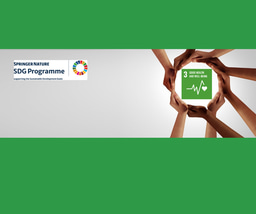World AIDS Day: Q&A with Dr Aaloke Mody
Published in Healthcare & Nursing, General & Internal Medicine, and Public Health

Why did you decide to go into your field of research?
I hadn’t always wanted to be a physician. During college, I was drawn towards medicine because of the prospect of working in global and public health as a strategy to combat the legacies of socioeconomic and political injustices and inequities. At that time, deaths from HIV were at their peak and global health efforts to combat HIV worldwide were really ramping up, so infectious diseases seemed like a natural choice. As I progressed through training, this choice was reified as I saw how the HIV field was very often at the forefront of acknowledging that so many factors beyond biomedical and clinical issues—like social determinants of health—were going to determine whether treatment was successful or not. If we couldn’t deliver care that supported individuals remaining retained in care and adherent to medications, and following through with treatment plans, our care would not achieve the desired outcomes regardless of how advanced our therapies had become and the clinical decisions we made. The first time I heard of “implementation science” was during my internal medicine residency training, and I realized that this was an academic home for the types of questions that I thought mattered most. How do we design care delivery to ensure that we are maximizing the population-level impact of the interventions and advances we have? Since then, I have been focused on building a research career on trying to help answer that question.
How has knowledge of HIV/AIDS developed over the course of your career?
The story of HIV over the past few decades is really a remarkable one. In the first 30 years, HIV went from an unknown virus to have multiple highly simple and highly efficacious medications available for both treatment and prevention (e.g., PrEP and treatment as prevention). In the past 15 years, I would say the global HIV treatment response has really evolved into understanding how to ensure we can get these remarkable and life-saving therapies to everyone in the world living with HIV. This has naturally drawn a lot of attention to learning how to best deliver care, including how to make sure it is more person-centered, flexible, and tailored for addressing barriers across diverse populations. These innovations have not only been important for HIV, but they have also helped make HIV care a model for chronic disease care delivery, even for diseases that have been around much longer like hypertension and diabetes. For example, challenges with retention and reengagement in care also significantly limit optimal health outcomes in other lifelong chronic diseases, but there are has historically been less attention on these issues. Although innovations in care delivery is where most of my research focus is, it is important to note other biomedical advances, particularly with long-acting injectable therapies. We are just seeing the first generation of these products, but full treatment regimens that can be administered once every 6 months are on the horizon and have potential to completely alter what is needed for successful care delivery.
What challenges do those from low- and middle-income countries in particular face?
There are both challenges and enormous promise from the HIV response in low- and middle-income countries. Many of the challenges are well-known and include inadequately funded public health infrastructure, limited access to new advances, particularly long-acting injectable therapies, reductions in global health funding as well as socioeconomic and political inequities driven by legacies of colonialism and racism, legal discrimination and punitive laws, and gender inequity and violence. At every level of society (global, country, city, neighborhood-level), inequalities continue to drive the HIV epidemic and equitable access to prevention and treatment services across all populations is needed. At the same time, I think there is a lot of promise in the HIV response in low- and middle-income countries. Many countries, particularly in Africa, have HIV care cascades (i.e., the proportion of the population with HIV who have been successfully diagnosed, started on medications, and achieved viral suppression) that indicate better outcomes than in high income countries like the US. Much of the innovation in care delivery is being driven by HIV research and programs in low- and middle-income countries, and they serve as a model for high-income countries to learn from.
What does public engagement look like in your field and how important do you think it is for researchers to make a societal impact with their work?
Active public engagement has always been a cornerstone of the HIV response. From the early days, there was a lot of activism in HIV to ensure that scientific advances actually led to impact in people’s lives, initially by speeding up the drug pipeline when no effective regimens were available and later around ensuring access to medications globally. Given my focus on implementation science, it is not surprising that I feel strongly that the research we do should have a fairly direct societal impact. It is critical at the inception to engage individuals and community in framing the important questions to be answered and designing the research study to ensure that it will yield results that will meet the needs and preferences of that community. In our work, we often employ methods like quantitative preference studies (e.g., discrete choice and best-worse scaling experiments), human centered design, and other mixed methods evaluations to ensure that our work is maximally relevant for the intended population. At the other end, I think the researcher’s role in helping to ensure that their findings get appropriately disseminated into policy and practice is also being increasingly recognized. In truth, there are many scientific questions regarding how to optimally disseminate research findings to ensure they have societal impact, and we are only at the beginning of the journey in answering them.
What are your hopes for progress in the future?
There are numerous, but broadly speaking, I am looking forward to seeing how lessons from HIV will be leveraged in building up person-centered care delivery systems that integrate care beyond typical disease silos. How do we ensure that care delivery systems are flexible enough to ensure they are accommodating to everyone’s needs and preferences, rather than the other way around. Also, there is already a growing body of research on integrating care for one or two other diseases with HIV, but I think these sets of questions can be taken several steps forward: what does an integrated person-centered health system that provides comprehensive care for HIV treatment and prevention, hypertension, diabetes, cancer screening, mental health, and beyond? Many of the building blocks are there but is yet to be seen how they all fit together across different contexts. In recent Seminar paper1 that we wrote, we actually discuss these issues more in depth our perspectives on the current state of the HIV response and where it is heading.
- Mody A, Sohn AH, Iwuji C, Tan RKJ, Venter F, Geng EH. HIV epidemiology, prevention, treatment, and implementation strategies for public health. The Lancet 2024; 403(10425): 471-92.
Follow the Topic
-
Implementation Science Communications

An official companion journal to Implementation Science and a forum to publish research relevant to the systematic study of approaches to foster uptake of evidence based practices and policies that affect health care delivery and health outcomes, in clinical, organizational, or policy contexts.
Related Collections
With Collections, you can get published faster and increase your visibility.
Advancing the Science and Metrics on the Pace of Implementation
The persistent 17-year span between discovery and application of evidence in practice has been a rallying cry for implementation science. That frequently quoted time period often implies that implementation needs to occur faster. But what do we really know about the time required to implement new evidence-based practices into routine settings of care. Does implementation take 17 years? Is implementation too slow? Can it be accelerated? Or, does a slower pace of implementing new evidence-based innovations serve a critical function? In many cases—pandemics, health inequities, urgent social crises—pressing needs demand timely implementation of rapidly accruing evidence to reduce morbidity and mortality. Yet many central tenets of implementation, such as trust, constituent inclusion, and adaptation, take time and may require a slow pace to ensure acceptability and sustained uptake.
To date, little attention and scant data address the pace of implementation. Speed is a rarely studied or reported metric in implementation science. Few in the field can answer the question, “how long does implementation take?” Answering that question requires data on how long various implementation phases take, or how long it takes to achieve implementation outcomes such as fidelity, adoption, and sustainment. Importantly, we lack good data on how different implementation strategies may influence the amount of time to achieve given outcomes.
To advance knowledge about how long implementation takes and how long it “should optimally” take, this collection seeks to stimulate the publication of papers that can advance the measurement of implementation speed, along with the systematic study of influences on and impacts of speed across diverse contexts, to more adequately respond to emerging health crises and benefit from emerging health innovations for practice and policy. In particular, we welcome submissions on 1) methodological papers that facilitate development, specification, and reporting on metrics of speed, and 2) data-based research (descriptive or inferential) that reports on implementation speed metrics, contextual factors and/or active strategies that affect speed, or the effects of implementation speed on important outcomes in various contexts.
Areas of interest include but are not limited to:
• Data based papers documenting pace of moving through various implementation phases, and identifying factors (e.g., implementation context, process, strategies) that affect pace of implementation (e.g., accelerators and inhibitors)
• Data based papers from multi-site, including multi-national, studies comparing pace of innovation adoption, implementation, and sustainment across various contexts
• Data based papers reporting time to implementation in the face of urgent social conditions (e.g., climate change, disaster relief) Papers on how to accelerate time to delivery of treatment discoveries for specific health conditions (e.g., cancer, infectious disease, suicidality, opioid epidemic)
• Data based papers on the timeliness of policy implementation, including factors influencing the time from data synthesis to policy recommendation, and from policy recommendation to implementation
• Span of time needed to: achieve partner collaboration, including global health partnerships adapt interventions to make them more feasible, usable, or acceptable achieve specific implementation outcomes (e.g., adoption, fidelity, scale-up, sustainment) de-implement harmful or low-value innovations, or to identify failed implementation efforts
• Effect of implementation pace on attainment of key outcomes such as constituent engagement, intervention acceptability or sustainability, health equity, or other evidence of clinical, community, economic, and/or policy benefits.
• Papers addressing the interplay between pace and health equity, speed and sustainability, and other considerations that impact decision-making on implementation
• Methodological pieces that advance designs for testing speed or metrics for capturing the pace of implementation
• This Collection welcomes submission of a range of article types. Should you wish to submit to this Collection, please read the submission guidelines of the journal you are submitting to Implementation Science or Implementation Science Communications to confirm that type is accepted by the journal you are submitting to.
• Articles for this Collection should be submitted via our submission systems in Implementation Science or Implementation Science Communications. During the submission process you will be asked whether you are submitting to a Collection, please select "Advancing the Science and Metrics on the Pace of Implementation" from the dropdown menu.
• Articles will undergo the standard peer-review process of the journal they are considered in Implementation Science or Implementation Science Communications and are subject to all of the journal’s standard policies. Articles will be added to the Collection as they are published.
• The Editors have no competing interests with the submissions which they handle through the peer-review process. The peer-review of any submissions for which the Editors have competing interests is handled by another Editorial Board Member who has no competing interests.
Publishing Model: Open Access
Deadline: Dec 31, 2025





Please sign in or register for FREE
If you are a registered user on Research Communities by Springer Nature, please sign in